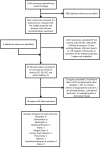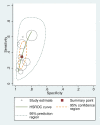The Diagnostic Value of Capillary Refill Time for Detecting Serious Illness in Children: A Systematic Review and Meta-Analysis
- PMID: 26375953
- PMCID: PMC4573516
- DOI: 10.1371/journal.pone.0138155
The Diagnostic Value of Capillary Refill Time for Detecting Serious Illness in Children: A Systematic Review and Meta-Analysis
Abstract
Importance: Capillary refill time (CRT) is widely recommended as part of the routine assessment of unwell children.
Objective: To determine the diagnostic value of capillary refill time for a range of serious outcomes in children.
Methods: We searched Medline, Embase and CINAHL from inception to June 2014. We included studies that measured both capillary refill time and a relevant clinical outcome such as mortality, dehydration, meningitis, or other serious illnesses in children aged up to 18 years of age. We screened 1,265 references, of which 24 papers were included in this review. Where sufficient studies were available, we conducted meta-analysis and constructed hierarchical summary ROC curves.
Results: Meta-analysis on the relationship between capillary refill time and mortality resulted in sensitivity of 34.6% (95% CI 23.9 to 47.1%), specificity 92.3% (88.6 to 94.8%), positive likelihood ratio 4.49 (3.06 to 6.57), and negative likelihood ratio 0.71 (0.60 to 0.84). Studies of children attending Emergency Departments with vomiting and diarrhea showed that capillary refill time had specificity of 89 to 94% for identifying 5% dehydration, but sensitivity ranged from 0 to 94%. This level of heterogeneity precluded formal meta-analysis of this outcome. Meta-analysis was not possible for other outcomes due to insufficient data, but we found consistently high specificity for a range of outcomes including meningitis, sepsis, admission to hospital, hypoxia, severity of illness and dengue.
Conclusions: Our results show that capillary refill time is a specific sign, indicating that it can be used as a "red-flag": children with prolonged capillary refill time have a four-fold risk of dying compared to children with normal capillary refill time. The low sensitivity means that a normal capillary refill time should not reassure clinicians.
Conflict of interest statement
Figures





References
-
- Mackway-Jones K, Advanced Life Support Group (Manchester England). Advanced paediatric life support: the practical approach 4th ed. Malden, Mass.: Blackwell; 2005.
-
- Ralston M, American Heart Association., American Academy of Pediatrics. PALS provider manual Dallas, Tex.: American Heart Association; 2006. viii, 274 p. p.
-
- World Health Organization. Department of Child and Adolescent Health and Development., UNICEF. Management of the child with a serious infection or severe malnutrition: guidelines for care at the first-referral level in developing countries Geneva: Dept. of Child and Adolescent Health and Development UNICEF; 2000. xiii, 162 p. p.
-
- Brierley J, Carcillo JA, Choong K, Cornell T, Decaen A, Deymann A, et al. Clinical practice parameters for hemodynamic support of pediatric and neonatal septic shock: 2007 update from the American College of Critical Care Medicine. Critical care medicine. 2009;37(2):666–88. Epub 2009/03/28. 10.1097/CCM.0b013e31819323c6 . - DOI - PMC - PubMed
Publication types
MeSH terms
LinkOut - more resources
Full Text Sources
Other Literature Sources
Medical
Research Materials

